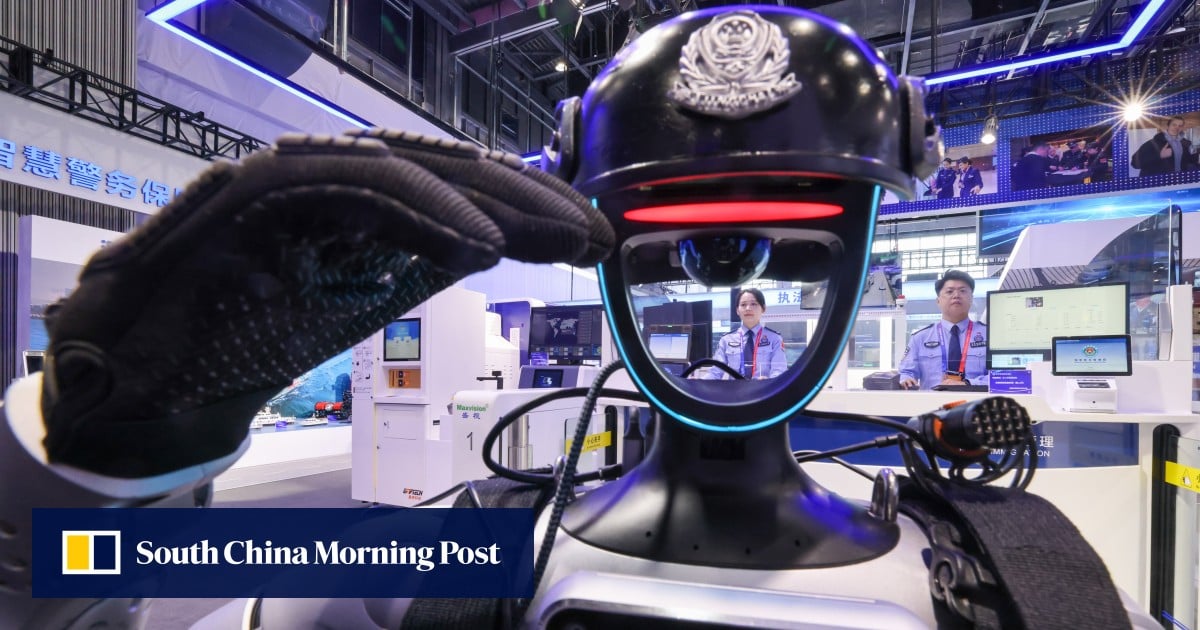The Future of Policing in China: AI-Driven Surveillance Takes Center Stage
Introduction: A New Era of Law Enforcement
The landscape of law enforcement is rapidly transforming, particularly in China, where artificial intelligence (AI) is set to revolutionize policing methods. At the recent 12th China International Exhibition on Police Equipment held in Beijing, cutting-edge surveillance tools were on display, showcasing the future of policing. This annual expo is not just a showcase; it’s a glimpse into how technology will shape public safety and security.
AI Surveillance: Monitoring Communication Channels
One of the most striking features of the technologies presented at the expo was their ability to monitor communication platforms like Telegram and VPN users. As digital communication continues to expand, the need for advanced surveillance tools has become paramount. This capability raises critical questions about privacy, civil liberties, and the role of technology in modern governance.
DeepSeek Models: The Next Step in Investigative Work
Among the innovations highlighted was the use of DeepSeek-inspired models. These sophisticated algorithms can analyze vast amounts of data to identify trends and leads in criminal investigations. This technology aims to streamline the investigative process by providing law enforcement with actionable insights, making it easier to solve cases efficiently and effectively.
A Platform for Suppliers: The Expo’s Role
The expo served as a competitive arena for police and defense equipment suppliers from across China. It provided a unique opportunity for various companies, including research institutes affiliated with the Ministry of Public Security, to showcase their latest innovations. The event highlighted the growing collaboration between public security agencies and private sector developers in the field of policing technology.
AI: The Star of the Show
Artificial intelligence was undeniably the star of the exhibition, captivating attendees with its potential for transforming policing. From advanced surveillance tools to criminal investigation devices and even drone-jamming equipment, AI was showcased as a versatile technology that can enhance various aspects of law enforcement.
Multidimensional Intelligence Analysis: A Breakthrough Technology
One of the standout technologies presented was the “multidimensional intelligence analysis of individual extreme behavior”. Developed by the Third Research Institute of the Ministry of Public Security, this tool aims to identify and analyze extreme behaviors that may pose a threat to public safety. By leveraging AI, this technology can help authorities take preventive measures before incidents escalate.
The Importance of Collaboration
The expo highlighted the importance of collaboration between public security agencies and private companies. This partnership is crucial for developing technologies that meet the unique needs of law enforcement. As policing becomes increasingly complex, the synergy between these sectors will be vital for creating effective solutions.
Ethical Considerations: Balancing Security and Privacy
While the advancements in policing technology offer promising benefits, they also raise significant ethical considerations. The ability to monitor communications and analyze individual behaviors poses challenges to privacy rights. Striking the right balance between ensuring public safety and respecting individual freedoms will be a critical issue for policymakers moving forward.
The Global Context: China’s Position in Technological Advancements
China’s push toward AI-driven policing is part of a broader global trend where nations are increasingly adopting technology to enhance law enforcement capabilities. As countries grapple with rising crime rates and public safety concerns, China’s developments place it at the forefront of this technological revolution. However, this also invites scrutiny from international observers concerning human rights and civil liberties.
Future Innovations: What Lies Ahead
As we look ahead, the potential for future innovations in policing technology seems limitless. With advancements in machine learning, data analytics, and biometrics, the landscape of law enforcement will continue to evolve. New tools will likely emerge, further enhancing the capabilities of police agencies to maintain public safety.
Training and Implementation: A Key Challenge
Implementing these advanced technologies will require comprehensive training for law enforcement personnel. Officers must be equipped not only with the technical skills to use these tools effectively but also with an understanding of the ethical implications involved. Ongoing training programs will be essential to ensure that technology is used responsibly and effectively.
Public Perception: The Role of Community Trust
As policing methods evolve, maintaining community trust will be paramount. The public’s perception of surveillance and AI-driven policing will significantly impact the effectiveness of these tools. Engaging communities in discussions about technology and its implications will be crucial for fostering an environment of transparency and cooperation.
Regulatory Framework: The Need for Guidelines
With the rapid advancement of policing technology, there is a pressing need for a robust regulatory framework. Policymakers must establish guidelines that define the ethical use of AI in law enforcement. Clear regulations will help protect citizens’ rights while allowing law enforcement to utilize technology effectively.
Cybersecurity: Protecting Sensitive Information
As law enforcement agencies adopt more technology, the importance of cybersecurity cannot be overstated. Protecting sensitive information from cyber threats will be a critical aspect of implementing AI tools. Agencies must invest in robust cybersecurity measures to safeguard their systems and maintain public trust.
International Cooperation: A Global Approach to Policing
The challenges posed by modern crime, including cybercrime and terrorism, require international cooperation. Countries must work together to share information and best practices in policing technology. Collaborative efforts will be essential for addressing transnational crime effectively.
Conclusion: A Transformative Journey Ahead
The future of policing in China is set to be heavily influenced by artificial intelligence and innovative surveillance technologies. As showcased at the recent expo, the potential for these tools to enhance public safety is immense. However, it is equally important to navigate the ethical, legal, and social implications that accompany these advancements. By fostering collaboration between sectors, engaging communities, and establishing robust regulations, China can harness the power of technology while safeguarding individual rights. The journey ahead promises to be transformative, shaping the future of law enforcement not just in China, but across the globe.








